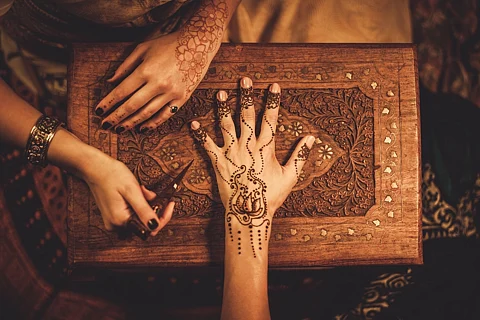

The deep-brown designs covering the hands of women add to the flare of dressing up during any festival celebrated in the subcontinent. Even during Eid, when the finest clothes in delicious colours are taken out from the unreachable shelves to be worn, ornate henna-covered palms complete the look. However, the tradition of applying henna or mehndi on Eid hasn't been borrowed recently. Instead, it's been deeply rooted in the Muslim culture and has a history that can be traced back centuries ago. While henna is commonly perceived as initially native to the subcontinent, it finds its root in Egypt. Moreover, apart from South Asia, henna's earthy scent and deep colour have lingered in regions such as Africa and the Middle East for more than 5000 years.
Derived from the Arabic term al-hinna, henna has been widely used for centuries to dye skin, hair, fabrics and fingernails, it continues to serve even now. However, the tradition of applying henna during Eid isn't just a mere embellishment complimenting the elaborate garments. As per lore, it was not only used by Prophet Muhammad to dye his hair but was also encouraged by him for special occasions. It is also believed that Prophet Muhammad used henna to purify himself before prayer and to wane off evil spirits.
This spiritual significance also extends to the belief that henna brings good luck and contains barakat, which refers to the unseen flow of positive energy, attracting blessings and shielding against evil spirits. In Sudan, the use of henna has been present since the time of ancient civilisations and continues to be popular, heralded by the belief in its sanctity. While in Egypt, henna has been in use for the last 9000 years—even by the queen of ancient Egyptian civilisation, Cleopatra. And in India, scholars believe, henna was introduced in the 12th century during the Mughal era.
Even the designs vary from region to region, taking on a distinct identity symbolic of the culture. In Muslim cultures, intricate patterns featuring geometric shapes, floral motifs, and Arabic calligraphy compose detailed designs. For example, symbols intrinsic to the Islamic culture, such as the crescent moon and star, are popular elements during Eid.
However, while henna is imbued with spiritual relevance, it also holds social and cultural significance. Applying henna, especially for festivals like Eid, is a communal tradition. Women of all ages come together to apply henna for each other, creating and reaffirming a sense of sisterhood and community. This tradition usually takes place on the eve of Eid al-Fitr, known as Chaand Raat or the 'night of the moon.'
Even today, this centuries-old practice finds relevance during Eid celebrations across the globe. While its intrinsic characteristic remains strong, henna has also become a medium for creating art with a strong narrative.
